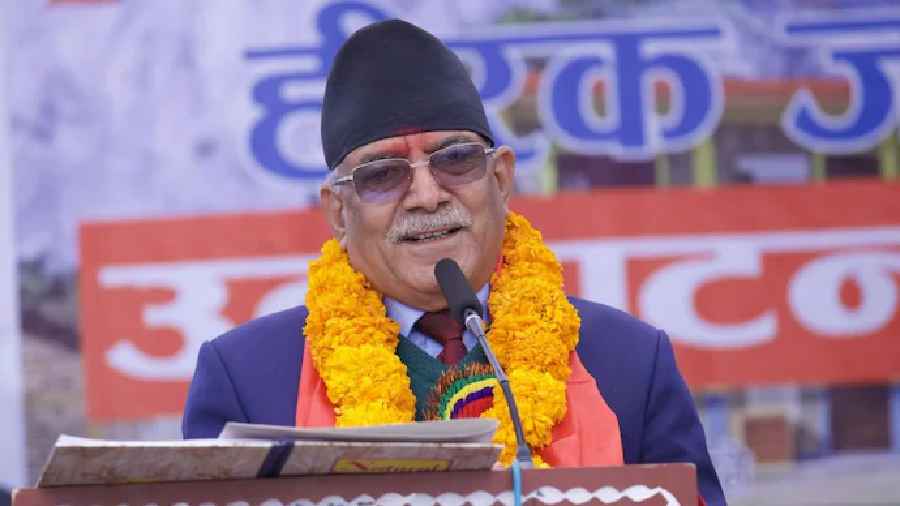No matter which government comes to power in Kathmandu, the bilateral ties between Nepal and India need to remain strong due to the cultural, economic and social proximity between the two countries, political analysts said on Monday as Pushpa Kamal Dahal "Prachanda" was sworn-in as the new prime minister of the landlocked nation.
Nilambar Acharya, former Nepalese ambassador to India, says the new government needs to maintain cordial relations with India though there may be differences in the working style of every dispensation.
Prachanda, 68, was appointed as Nepal's new premier by President Bidya Devi Bhandari after he surprisingly walked away from the five-party ruling alliance led by outgoing Prime Minister Sher Bahadur Deuba's Nepali Congress and staked a claim for the premier's post before the deadline set by the president expired on Sunday.
Prachanda was sworn in for the third time as the Prime Minister of Nepal on Monday.
"Of course, we have some issues with India, and the style of handling such issues may differ from the previous to the present government," Acharya says.
"All these issues, including the border problem, need to be resolved through diplomatic channels," he says.
The former diplomat adds that besides silent diplomacy, "sometimes we need to pursue open diplomacy in tackling various bilateral issues".
Prachanda and CPN-UML chair and former prime minister K P Oli, fiercest critics of each other until Saturday, had joined hands for a power-sharing deal on Sunday.
In Kathmandu, a sudden shift of camp by Prachanda to the CPN-UML and the consensus he was able to secure so quickly have taken many by surprise.
The surprise development may not bode well for India-Nepal ties as Prachanda and his main backer Oli have had some run-ins with New Delhi previously over territorial issues.
Prachanda is largely seen as pro-China. He has in the past said that a new understanding with India needed to be developed on the basis of a "changed scenario" in Nepal and after addressing all outstanding issues, like the revision of the 1950 Friendship Treaty and resolving Kalapani and Susta border disputes.
Acharya, however, opines that the new dispensation may not tilt towards either China or India in its foreign policy overtures.
"I do not think that the new government will either tilt towards China or India. Nepal needs to maintain cordial relations with both India and China, and we cannot develop the country by damaging its relations with the southern neighbour," he said.
The India-Nepal Treaty of Peace and Friendship of 1950 forms the bedrock of the special relations between the two countries.
Commenting on the new government, senior journalist Dhruba Hari Adhikari said Prachanda’s image as a radical leftist leaves room to suspect that his foreign policy measures may not be helpful in maintaining Nepal’s balanced relationship with its immediate neighbours -- India and China.
Senior journalist Mathwar Singh Basnet says the government is clearly tilted towards its northern neighbour.
"The first congratulation to Prachanda came from the Chinese envoy. Moreover, leaders of both the major alliance members -- CPN-Maoist Centre and CPN-UML -- are from a communist background and they do not believe in a democratic system," he says.
In a sarcastic remark, Kathmandu Metropolitan City mayor Balendra Shah says leaders representing three completely different ideologies -- "Those who want to reinstate the monarchy, those who abolished the monarchy, and those who wanted to slain the King" -- have joined hands to form the new government in Nepal.
"All three people (alliance partners) who said ‘the King should return’, ‘We don’t need King’ and ‘King should be slayed’ are in the government at present. However, common people are the ones who always suffer," Shah tweeted.
Nepal is important for India in the context of its overall strategic interests in the region, and the leaders of the two countries have often noted the age-old “Roti Beti” relationship.
Land-locked Nepal relies heavily on India for the transportation of goods and services. Nepal’s access to the sea is through India, and it imports a predominant proportion of its requirements from and through India.
Ties between the two countries came under severe strain after Kathmandu published a new political map in 2020 that showed the three Indian territories - Limpiyadhura, Kalapani and Lipulekh - as part of Nepal.
The then Prime Minister Oli attempted to use the issue to fend off increasing domestic pressure and challenge his leadership.
The country also shares a border of over 1,850 km with five Indian states – Sikkim, West Bengal, Bihar, Uttar Pradesh and Uttarakhand.











